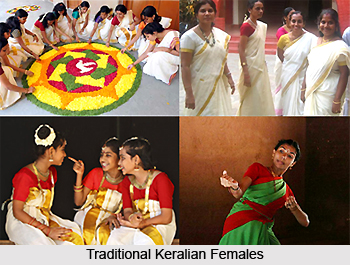Matrilineal form of society is considered to be one of the significant features of Kerala. It is also known as Marumakkathayam. Matrilineal succession forms a part of the society of Kerala. The medieval Kerala society was shaped not only by caste, but by a parallel system of matrilineal and patrilineal form of inheritance. Marumakkathayam or matrilineal system was likely the most widespread; it was followed by Kshatriya, Nayars (Nairs), Moplahs or Muslims of Malayali race, and Ambalavasis and to some extent by the Ezhavas and the outcaste groups. Among Hindus, the Kamalla castes of craftsmen and the Brahmins were the principal groups who followed Makkathayam or patrilineal inheritance, while the Jews, Christians, and Muslims of Arab descent also inherited patrilineally but differed from the Hindus by not living in joint families.
Origin of Matrilineal Form of Society in Kerala
Matriarchal society in Kerala refers to a particular form of society, where women play the leading role especially the mothers. Matriarchal society in Kerala is said to have emerged during the period of crisis when the second Chera Dynasty went down in the conflict with the Cholas around 985. Before that, there is also no evidence of matriarchy during this phase. Marumakkathayam centred on the tarwad, the Nayar family unit which consisted of all the descendants of a common ancestress in the female line; a man`s children had no rights within his tarwad, since they belonged to his wife`s family. The family property was administered by the eldest male member of the tarwad, who was called the Karnavan; he had absolute powers of decision so far as management of the estate was concerned, but he could alienate no portion of the family property without the unanimous consent of the junior members.
 The system was ideally suited for a warrior people; the junior male members of the tarwad were provided for and - since the land was farmed by members of the lower castes - they had nothing to do but to fight or prepare for fighting. From early youth they trained in the kalaris. The younger generations inherit property only through their mother`s side.
The system was ideally suited for a warrior people; the junior male members of the tarwad were provided for and - since the land was farmed by members of the lower castes - they had nothing to do but to fight or prepare for fighting. From early youth they trained in the kalaris. The younger generations inherit property only through their mother`s side.
The Nayar women had a considerable say in the affairs and enjoyed a freedom and security shared by very few women in India. Because of the tarwad system, the Nayars did not suffer from two of the great scourges of ordinary Indian marriages - the financially crippling dowry system and the socially induced tragedy of widowhood. Since the Nayar bride always retained her rights in the tarwad and her title to a share as a member equal to all others, and since in any case she continued to live at home, a dowry was not necessary. If her husband died, she merely lived on in her family home, a full member of the tarwad, instead of having to endure the humiliating treatment meted out by the husband`s family to most Indian widows belonging to different society. The very structure of the matrilineal joint family made it difficult for the younger Nayars to occupy themselves meaningfully once their military trade had gone.
With the approval of a majority of the Nayar community that the traditional systems of inheritance were changed by a series of statutes whose consequences were probably more revolutionary than those of any other legislation enacted in Kerala. The first was the Nayar Regulation of Travancore, passed as early as 1912, winch allowed a man to leave half his personal estate to his sons. In the year 1925, came a further Nayar Regulation, much more radical in its conception, which allowed the actual partition of any tarwad in equal shares to all members provided a majority voted in favour. Similar regulations in Malabar in the year 1933 and in Kochi in 1937 followed the pattern of the Travancore legislation.
When the matrilineal system broke up as the result of the impact of modernisation as well as social reform movements the structure of rural life collapsed in Kerala. The families which provided rural leadership were split into small units and the division of landed estates practically destroyed the landed aristocracy. However, the most significant effect of the matrilineal system is that it has left Malayali women with an influence and an independence of outlook which one will not find anywhere else in India. It had provided woman a suitable position within her own family, it has prevented widowhood from becoming the sordid tragedy which it was - and to a great extent still is - in the Indian Hindu societies.



















